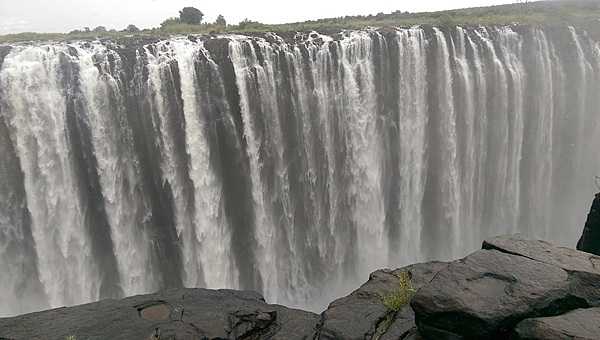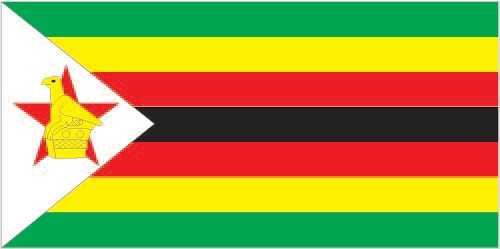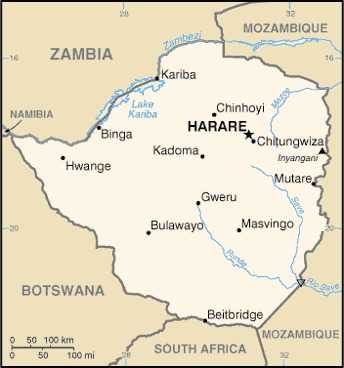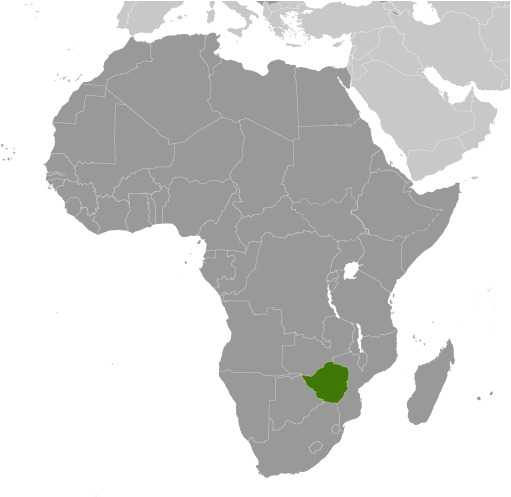Introduction
Background
The hunter-gatherer San people first inhabited the area that eventually became Zimbabwe. Farming communities migrated to the area around A.D. 500 during the Bantu expansion, and Shona-speaking societies began to develop in the Limpopo valley and Zimbabwean highlands around the 9th century. These societies traded with Arab merchants on the Indian Ocean coast and organized under the Kingdom of Mapungubwe in the 11th century. A series of powerful trade-oriented Shona states succeeded Mapungubwe, including the Kingdom of Zimbabwe (ca. 1220-1450), Kingdom of Mutapa (ca. 1450-1760), and the Rozwi Empire. The Rozwi Empire expelled Portuguese colonists from the Zimbabwean plateau, but the Ndebele clan of Zulu King MZILIKAZI eventually conquered the area in 1838 during the era of conflict and population displacement known as the Mfecane.
In the 1880s, colonists arrived with the British South Africa Company (BSAC) and obtained a written concession for mining rights from Ndebele King LOBENGULA. The king later disavowed the concession and accused the BSAC agents of deceit. The BSAC annexed Mashonaland and then conquered Matabeleland during the First Matabele War of 1893-1894, establishing company rule over the territory. In 1923, the UK annexed BSAC holdings south of the Zambezi River, which became the British colony of Southern Rhodesia. The 1930 Land Apportionment Act restricted Black land ownership and established rules that would favor the White minority for decades. A new constitution in 1961 further cemented White minority rule.
In 1965, the government under White Prime Minister Ian SMITH unilaterally declared its independence from the UK. London did not recognize Rhodesia’s independence and demanded more voting rights for the Black majority in the country. International diplomacy and an uprising by Black Zimbabweans led to biracial elections in 1979 and independence (as Zimbabwe) in 1980. Robert MUGABE, who led the uprising and became the nation's first prime minister, was the country's only ruler (as president since 1987) from independence until 2017. In the mid-1980s, the government tortured and killed thousands of civilians in a crackdown on dissent known as the Gukurahundi campaign. Economic mismanagement and chaotic implementation of land redistribution policies periodically crippled the economy. General elections in 2002, 2008, and 2013 were severely flawed and widely condemned but allowed MUGABE to remain president. In 2017, Vice President Emmerson MNANGAGWA became president after a military intervention that forced MUGABE to resign, and MNANGAGWA cemented power by sidelining rival Grace MUGABE (Robert MUGABE’s wife). In 2018, MNANGAGWA won the presidential election, and he has maintained the government's longstanding practice of violently disrupting protests and politicizing institutions. Economic conditions remain dire under MNANGAGWA.
Visit the Definitions and Notes page to view a description of each topic.
Geography
Location
Southern Africa, between South Africa and Zambia
Geographic coordinates
20 00 S, 30 00 E
Map references
Africa
Area - comparative
about four times the size of Indiana; slightly larger than Montana
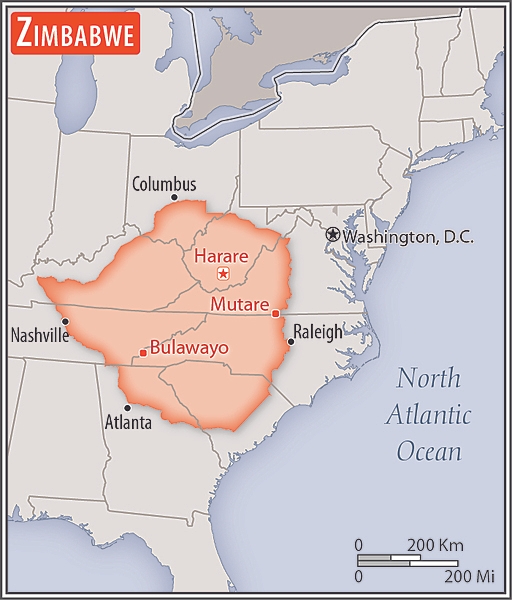
Land boundaries
total: 3,229 km
border countries (4): Botswana 834 km; Mozambique 1,402 km; South Africa 230 km; Zambia 763 km
Coastline
0 km (landlocked)
Maritime claims
none (landlocked)
Climate
tropical; moderated by altitude; rainy season (November to March)
Terrain
mostly high plateau with higher central plateau (high veld); mountains in east
Elevation
highest point: Inyangani 2,592 m
lowest point: junction of the Runde and Save Rivers 162 m
mean elevation: 961 m
Natural resources
coal, chromium ore, asbestos, gold, nickel, copper, iron ore, vanadium, lithium, tin, platinum group metals
Land use
agricultural land: 42.5% (2018 est.)
arable land: 10.9% (2018 est.)
permanent crops: 0.3% (2018 est.)
permanent pasture: 31.3% (2018 est.)
forest: 39.5% (2018 est.)
other: 18% (2018 est.)
Irrigated land
1,740 sq km (2012)
Major rivers (by length in km)
Zambezi (shared with Zambia [s]), Angola, Namibia, Botswana, and Mozambique [m]) - 2,740 km; Limpopo (shared with South Africa [s], Botswana, and Mozambique [m]) - 1,800 km
note – [s] after country name indicates river source; [m] after country name indicates river mouth
Major watersheds (area sq km)
Indian Ocean drainage: Zambezi (1,332,412 sq km)
Internal (endorheic basin) drainage: Okavango Basin (863,866 sq km)
Major aquifers
Upper Kalahari-Cuvelai-Upper Zambezi Basin
Population distribution
Aside from major urban agglomerations in Harare and Bulawayo, population distribution is fairly even, with slightly greater overall numbers in the eastern half as shown in this population distribution map
Natural hazards
recurring droughts; floods and severe storms are rare
Geography - note
landlocked; the Zambezi forms a natural riverine boundary with Zambia; in full flood (February-April) the massive Victoria Falls on the river forms the world's largest curtain of falling water; Lake Kariba on the Zambia-Zimbabwe border forms the world's largest reservoir by volume (180 cu km; 43 cu mi)
People and Society
Population
total: 17,150,352
male: 8,343,790
female: 8,806,562 (2024 est.)
comparison rankings: female 72; male 72; total 72
Nationality
noun: Zimbabwean(s)
adjective: Zimbabwean
Ethnic groups
African 99.6% (predominantly Shona; Ndebele is the second largest ethnic group), other (includes Caucasian, Asiatic, mixed race) 0.4% (2022 est.)
Languages
Shona (official; most widely spoken) 80.9%, Ndebele (official, second most widely spoken) 11.5%, English (official; traditionally used for official business) 0.3%, 13 minority languages (official; includes Chewa, Chibarwe, Kalanga, Koisan, Nambya, Ndau, Shangani, sign language, Sotho, Tonga, Tswana, Venda, and Xhosa) 7%, other 0.3% (2022 est.)
note: data represent population by mother tongue
Religions
Apostolic Sect 40.3%, Pentecostal 17%, Protestant 13.8%, other Christian 7.8%, Roman Catholic 6.4%, African traditionalist 5%, other 1.5% (includes Muslim, Jewish, Hindu), none 8.3% (2022 est.)
Demographic profile
Zimbabwe’s progress in reproductive, maternal, and child health has stagnated in recent years. According to a 2010 Demographic and Health Survey, contraceptive use, the number of births attended by skilled practitioners, and child mortality have either stalled or somewhat deteriorated since the mid-2000s. Zimbabwe’s total fertility rate has remained fairly stable at about 4 children per woman for the last two decades, although an uptick in the urban birth rate in recent years has caused a slight rise in the country’s overall fertility rate. Zimbabwe’s HIV prevalence rate dropped from approximately 29% to 15% since 1997 but remains among the world’s highest and continues to suppress the country’s life expectancy rate. The proliferation of HIV/AIDS information and prevention programs and personal experience with those suffering or dying from the disease have helped to change sexual behavior and reduce the epidemic.
Historically, the vast majority of Zimbabwe’s migration has been internal – a rural-urban flow. In terms of international migration, over the last 40 years Zimbabwe has gradually shifted from being a destination country to one of emigration and, to a lesser degree, one of transit (for East African illegal migrants traveling to South Africa). As a British colony, Zimbabwe attracted significant numbers of permanent immigrants from the UK and other European countries, as well as temporary economic migrants from Malawi, Mozambique, and Zambia. Although Zimbabweans have migrated to South Africa since the beginning of the 20th century to work as miners, the first major exodus from the country occurred in the years before and after independence in 1980. The outward migration was politically and racially influenced; a large share of the white population of European origin chose to leave rather than live under a new black-majority government.
In the 1990s and 2000s, economic mismanagement and hyperinflation sparked a second, more diverse wave of emigration. This massive outmigration – primarily to other southern African countries, the UK, and the US – has created a variety of challenges, including brain drain, illegal migration, and human smuggling and trafficking. Several factors have pushed highly skilled workers to go abroad, including unemployment, lower wages, a lack of resources, and few opportunities for career growth.
Age structure
0-14 years: 38.3% (male 3,315,075/female 3,254,643)
15-64 years: 57.8% (male 4,758,120/female 5,152,773)
65 years and over: 3.9% (2024 est.) (male 270,595/female 399,146)
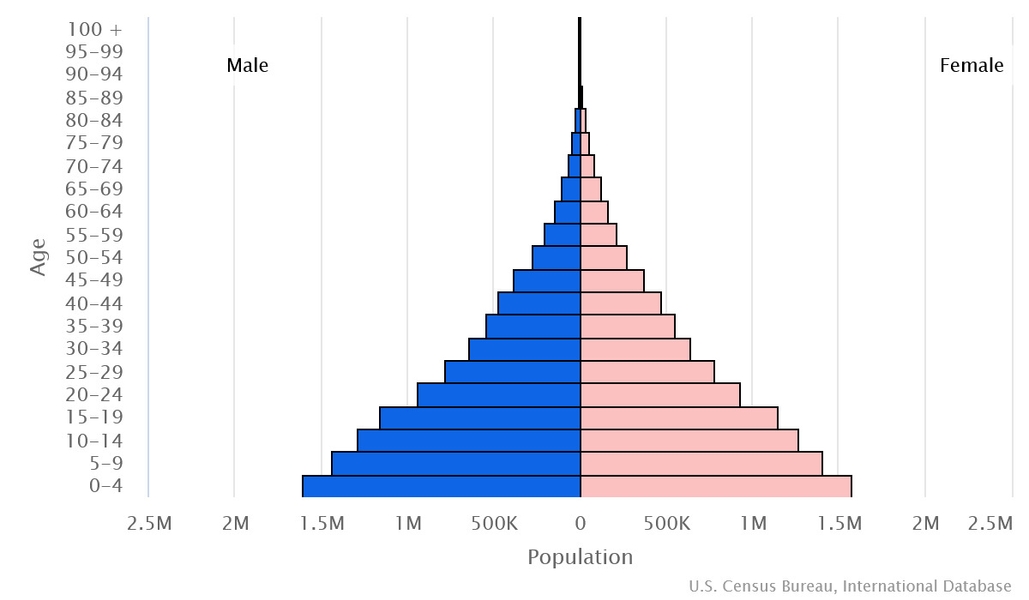
Dependency ratios
total dependency ratio: 79.4
youth dependency ratio: 73.4
elderly dependency ratio: 6
potential support ratio: 16.6 (2021 est.)
Median age
total: 21.2 years (2024 est.)
male: 20.3 years
female: 22 years
comparison ranking: total 194
Population distribution
Aside from major urban agglomerations in Harare and Bulawayo, population distribution is fairly even, with slightly greater overall numbers in the eastern half as shown in this population distribution map
Urbanization
urban population: 32.5% of total population (2023)
rate of urbanization: 2.41% annual rate of change (2020-25 est.)
Major urban areas - population
1.578 million HARARE (capital) (2023)
Sex ratio
at birth: 1.03 male(s)/female
0-14 years: 1.02 male(s)/female
15-64 years: 0.92 male(s)/female
65 years and over: 0.68 male(s)/female
total population: 0.95 male(s)/female (2024 est.)
Mother's mean age at first birth
20.3 years (2015 est.)
note: data represents median age at first birth among women 25-49
Infant mortality rate
total: 33.4 deaths/1,000 live births (2024 est.)
male: 37 deaths/1,000 live births
female: 29.6 deaths/1,000 live births
comparison ranking: total 39
Life expectancy at birth
total population: 67.2 years (2024 est.)
male: 65.6 years
female: 68.8 years
comparison ranking: total population 198
Gross reproduction rate
1.71 (2024 est.)
Contraceptive prevalence rate
66.8% (2015)
Drinking water source
improved: urban: 97.9% of population
rural: 66.9% of population
total: 76.9% of population
unimproved: urban: 2.1% of population
rural: 33.1% of population
total: 23.1% of population (2020 est.)
Current health expenditure
3.4% of GDP (2020)
Physician density
0.2 physicians/1,000 population (2020)
Hospital bed density
1.7 beds/1,000 population (2011)
Sanitation facility access
improved: urban: 96.1% of population
rural: 49% of population
total: 64.2% of population
unimproved: urban: 3.9% of population
rural: 51% of population
total: 35.8% of population (2017 est.)
Major infectious diseases
degree of risk: high (2023)
food or waterborne diseases: bacterial and protozoal diarrhea, hepatitis A, and typhoid fever
vectorborne diseases: malaria, dengue fever, and sexually transmitted diseases: HIV/AIDS (2024)
water contact diseases: schistosomiasis
animal contact diseases: rabies
Alcohol consumption per capita
total: 3.11 liters of pure alcohol (2019 est.)
beer: 1.2 liters of pure alcohol (2019 est.)
wine: 0.05 liters of pure alcohol (2019 est.)
spirits: 0.39 liters of pure alcohol (2019 est.)
other alcohols: 1.47 liters of pure alcohol (2019 est.)
comparison ranking: total 110
Tobacco use
total: 11.7% (2020 est.)
male: 21.8% (2020 est.)
female: 1.5% (2020 est.)
comparison ranking: total 125
Currently married women (ages 15-49)
61.6% (2023 est.)
Child marriage
women married by age 15: 5.4%
women married by age 18: 33.7%
men married by age 18: 1.9% (2019 est.)
Literacy
definition: any person age 15 and above who completed at least grade 3 of primary education
total population: 89.7%
male: 88.3%
female: 90.9% (2021)
School life expectancy (primary to tertiary education)
total: 11 years
male: 12 years
female: 11 years (2013)
Environment
Environment - current issues
deforestation; soil erosion; land degradation; air and water pollution; the black rhinoceros herd - once the largest concentration of the species in the world - has been significantly reduced by poaching; poor mining practices have led to toxic waste and heavy metal pollution
Environment - international agreements
party to: Biodiversity, Climate Change, Climate Change-Kyoto Protocol, Climate Change-Paris Agreement, Comprehensive Nuclear Test Ban, Desertification, Endangered Species, Hazardous Wastes, Law of the Sea, Ozone Layer Protection, Wetlands
signed, but not ratified: none of the selected agreements
Climate
tropical; moderated by altitude; rainy season (November to March)
Land use
agricultural land: 42.5% (2018 est.)
arable land: 10.9% (2018 est.)
permanent crops: 0.3% (2018 est.)
permanent pasture: 31.3% (2018 est.)
forest: 39.5% (2018 est.)
other: 18% (2018 est.)
Urbanization
urban population: 32.5% of total population (2023)
rate of urbanization: 2.41% annual rate of change (2020-25 est.)
Food insecurity
widespread lack of access: due to high food prices - based on a government assessment, an estimated 3.8 million people are expected to be in need of humanitarian assistance between January and March 2023; this number is higher than the level estimated in the first quarter of 2022; the downturn in food security conditions is largely on account of poor food access resulting from prevailing high food prices and reduced incomes owing to the effects of an economic downturn; a decline in cereal production in 2022 has also aggravated conditions (2023)
Air pollutants
particulate matter emissions: 13.08 micrograms per cubic meter (2019 est.)
carbon dioxide emissions: 10.98 megatons (2016 est.)
methane emissions: 12.1 megatons (2020 est.)
Waste and recycling
municipal solid waste generated annually: 1,449,752 tons (2015 est.)
municipal solid waste recycled annually: 231,960 tons (2005 est.)
percent of municipal solid waste recycled: 16% (2005 est.)
Major rivers (by length in km)
Zambezi (shared with Zambia [s]), Angola, Namibia, Botswana, and Mozambique [m]) - 2,740 km; Limpopo (shared with South Africa [s], Botswana, and Mozambique [m]) - 1,800 km
note – [s] after country name indicates river source; [m] after country name indicates river mouth
Major watersheds (area sq km)
Indian Ocean drainage: Zambezi (1,332,412 sq km)
Internal (endorheic basin) drainage: Okavango Basin (863,866 sq km)
Major aquifers
Upper Kalahari-Cuvelai-Upper Zambezi Basin
Total water withdrawal
municipal: 650 million cubic meters (2020 est.)
industrial: 80 million cubic meters (2020 est.)
agricultural: 3.04 billion cubic meters (2020 est.)
Total renewable water resources
20 billion cubic meters (2020 est.)
Government
Country name
conventional long form: Republic of Zimbabwe
conventional short form: Zimbabwe
former: Southern Rhodesia, Rhodesia, Zimbabwe-Rhodesia
etymology: takes its name from the Kingdom of Zimbabwe (13th-15th century) and its capital of Great Zimbabwe, the largest stone structure in pre-colonial southern Africa
Government type
presidential republic
Capital
name: Harare
geographic coordinates: 17 49 S, 31 02 E
time difference: UTC+2 (7 hours ahead of Washington, DC, during Standard Time)
etymology: named after a village of Harare at the site of the present capital; the village name derived from a Shona chieftain, NE-HARAWA, whose name meant "he who does not sleep"
Administrative divisions
8 provinces and 2 cities* with provincial status; Bulawayo*, Harare*, Manicaland, Mashonaland Central, Mashonaland East, Mashonaland West, Masvingo, Matabeleland North, Matabeleland South, Midlands
Independence
18 April 1980 (from the UK)
National holiday
Independence Day, 18 April (1980)
Constitution
history: previous 1965 (at Rhodesian independence), 1979 (Lancaster House Agreement), 1980 (at Zimbabwean independence); latest final draft completed January 2013, approved by referendum 16 March 2013, approved by Parliament 9 May 2013, effective 22 May 2013
amendments: proposed by the Senate or by the National Assembly; passage requires two-thirds majority vote by the membership of both houses of Parliament and assent of the president of the republic; amendments to constitutional chapters on fundamental human rights and freedoms and on agricultural lands also require approval by a majority of votes cast in a referendum; amended many times, last in 2017
Legal system
mixed legal system of English common law, Roman-Dutch civil law, and customary law
International law organization participation
has not submitted an ICJ jurisdiction declaration; non-party state to the ICCt
Citizenship
citizenship by birth: no
citizenship by descent only: the father must be a citizen of Zimbabwe; in the case of a child born out of wedlock, the mother must be a citizen
dual citizenship recognized: no
residency requirement for naturalization: 5 years
Suffrage
18 years of age; universal
Executive branch
chief of state: President Emmerson Dambudzo MNANGAGWA (since 4 September 2023)
head of government: Vice President Constantino CHIWENGA (since 11 September 2023)
cabinet: Cabinet appointed by president, responsible to National Assembly
elections/appointments: each presidential candidate nominated with a nomination paper signed by at least 10 registered voters (at least 1 candidate from each province) and directly elected by absolute majority popular vote in 2 rounds if needed for a 5-year term (no term limits); election last held on 23 August 2023 (next to be held in 2028); co-vice presidents drawn from party leadership
election results:
2023: Emmerson MNANGAGWA reelected president in first round; percent of vote - Emmerson MNANGAGWA (ZANU-PF) 52.6%, Nelson CHAMISA (MDC-T) 44%, Wilbert MUBAIWA (NPC) 1.2%, other 2.2%
2018: Emmerson MNANGAGWA elected president in first round; percent of vote - Emmerson MNANGAGWA (ZANU-PF) 50.7%, Nelson CHAMISA (MDC-T) 44.4%, Thokozani KHUPE (MDC-N) 0.9%, other 4%
Legislative branch
description: bicameral Parliament consists of:
Senate (80 seats; 60 members directly elected in multi-seat constituencies - 6 seats in each of the 10 provinces - by proportional representation vote, 16 indirectly elected by the regional governing councils, 18 reserved for the National Council Chiefs, and 2 reserved for members with disabilities; members serve 5-year terms)
National Assembly (280 seats; 210 members directly elected in single-seat constituencies by simple majority vote and 60 seats reserved for women directly elected by proportional representation vote and 10 additional seats reserved for candidates aged between 21 and 35 directly elected by proportional representation, members serve 5-year terms)
elections:
Senate - last held for elected member on 23 August 2023 (next to be held in 2028)
National Assembly - last held on 23 August 2023 (next to be held in 2028); note - a byelection was held on 11 November 2023 due to the death of a candidate during the August general election; a special byelection was held on 9 December 2023 after nine opposition lawmakers were removed from their seats and disqualified from running again; another byelection was held on 3 February 2024 for six open seats
election results:
Senate - percent of vote by party - NA; seats by party - ZANU-PF 33, CCC- 27, Chiefs 18, people with disabilities 2; composition - men 36, women 35, percentage of women 49.3%
National Assembly - percent of vote by party - NA; seats by party - ZANU-PF 190, CCC-93; composition - men 192, women 75, percentage women 28.1%; total Parliament percentage women 32.5%
Judicial branch
highest court(s): Supreme Court (consists of the chief justice and 4 judges); Constitutional Court (consists of the chief and deputy chief justices and 9 judges)
judge selection and term of office: Supreme Court judges appointed by the president upon recommendation of the Judicial Service Commission, an independent body consisting of the chief justice, Public Service Commission chairman, attorney general, and 2-3 members appointed by the president; judges normally serve until age 65 but can elect to serve until age 70; Constitutional Court judge appointment NA; judges serve nonrenewable 15-year terms
subordinate courts: High Court; Labor Court; Administrative Court; regional magistrate courts; customary law courts; special courts
Political parties and leaders
Citizens Coalition for Change (vacant)
Movement for Democratic Change - MDC-T [Douglas MWONZORA]
National People's Congress- NPC- [Wilbert MUBAIWA]
Zimbabwe African National Union-Patriotic Front or ZANU-PF [Emmerson Dambudzo MNANGAGWA]
Zimbabwe African Peoples Union or ZAPU [Michael NKOMO]
International organization participation
ACP, AfDB, ATMIS, AU, COMESA, FAO, G-15, G-77, IAEA, IBRD, ICAO, ICRM, IDA, IFAD, IFC, IFRCS, ILO, IMF, IMO, Interpol, IOC, IOM, IPU, ISO, ITSO, ITU, ITUC (NGOs), MIGA, NAM, OPCW, PCA, SADC, UN, UNAMID, UNCTAD, UNESCO, UNIDO, UNISFA, UNMIL, UNMISS, UNOCI, UNSOM, UNWTO, UPU, WCO, WFTU (NGOs), WHO, WIPO, WMO, WTO
Diplomatic representation in the US
chief of mission: Ambassador Tadeous Tafirenyika CHIFAMBA (since 7 July 2021)
chancery: 1608 New Hampshire Avenue NW, Washington, DC 20009
telephone: [1] (202) 332-7100
FAX: [1] (202) 483-9326
email address and website:
general@zimembassydc.org
https://zimembassydc.org/
Diplomatic representation from the US
chief of mission: Ambassador (vacant); Chargé d'Affaires Elaine M. FRENCH (since August 2022)
embassy: 2 Lorraine Drive, Bluffhill, Harare
mailing address: 2180 Harare Place, Washington DC 20521-2180
telephone: [263] 867-701-1000
FAX: [263] 24-233-4320
email address and website:
consularharare@state.gov
https://zw.usembassy.gov/
Flag description
seven equal horizontal bands of green (top), yellow, red, black, red, yellow, and green with a white isosceles triangle edged in black with its base on the hoist side; a yellow Zimbabwe bird representing the long history of the country is superimposed on a red five-pointed star in the center of the triangle, which symbolizes peace; green represents agriculture, yellow mineral wealth, red the blood shed to achieve independence, and black stands for the native people
National symbol(s)
Zimbabwe bird symbol, African fish eagle, flame lily; national colors: green, yellow, red, black, white
National anthem
name: "Kalibusiswe Ilizwe leZimbabwe" [Northern Ndebele language] "Simudzai Mureza WeZimbabwe" [Shona] (Blessed Be the Land of Zimbabwe)
lyrics/music: Solomon MUTSWAIRO/Fred Lecture CHANGUNDEGA
note: adopted 1994
National heritage
total World Heritage Sites: 5 (3 cultural, 2 natural)
selected World Heritage Site locales: Mana Pools National Park, Sapi, and Chewore Safari Areas (n); Great Zimbabwe National Monument (c); Khami Ruins National Monument (c); Mosi-oa-Tunya/Victoria Falls (n); Matobo Hills (c)
Economy
Economic overview
low income Sub-Saharan economy; political instability and endemic corruption have prevented reforms and stalled debt restructuring; new Zimbabwe Gold (ZiG) currency latest effort to combat ongoing hyperinflation; reliant on natural resource extraction, agriculture and remittances
Real GDP (purchasing power parity)
$58.583 billion (2023 est.)
$55.817 billion (2022 est.)
$52.399 billion (2021 est.)
note: data in 2021 dollars
comparison ranking: 115
Real GDP growth rate
4.96% (2023 est.)
6.52% (2022 est.)
8.47% (2021 est.)
note: annual GDP % growth based on constant local currency
comparison ranking: 57
Real GDP per capita
$3,500 (2023 est.)
$3,400 (2022 est.)
$3,300 (2021 est.)
note: data in 2021 dollars
comparison ranking: 192
GDP (official exchange rate)
$26.538 billion (2023 est.)
note: data in current dollars at official exchange rate
Inflation rate (consumer prices)
104.71% (2022 est.)
98.55% (2021 est.)
557.2% (2020 est.)
note: annual % change based on consumer prices
comparison ranking: 218
GDP - composition, by sector of origin
agriculture: 12% (2017 est.)
industry: 22.2% (2017 est.)
services: 65.8% (2017 est.)
comparison rankings: services 92; industry 129; agriculture 77
GDP - composition, by end use
household consumption: 77.6% (2017 est.)
government consumption: 24% (2017 est.)
investment in fixed capital: 12.6% (2017 est.)
investment in inventories: 0% (2017 est.)
exports of goods and services: 25.6% (2017 est.)
imports of goods and services: -39.9% (2017 est.)
Agricultural products
sugarcane, maize, beef, milk, cassava, wheat, bananas, vegetables, tobacco, cotton (2022)
note: top ten agricultural products based on tonnage
Industries
mining (coal, gold, platinum, copper, nickel, tin, diamonds, clay, numerous metallic and nonmetallic ores), steel, wood products, cement, chemicals, fertilizer, clothing and footwear, foodstuffs, beverages
Industrial production growth rate
5.5% (2022 est.)
note: annual % change in industrial value added based on constant local currency
comparison ranking: 47
Labor force
6.561 million (2023 est.)
note: number of people ages 15 or older who are employed or seeking work
comparison ranking: 71
Unemployment rate
8.76% (2023 est.)
10.09% (2022 est.)
9.54% (2021 est.)
note: % of labor force seeking employment
comparison ranking: 158
Youth unemployment rate (ages 15-24)
total: 7.3% (2021 est.)
male: 6.2%
female: 8.5%
comparison ranking: total 174
Population below poverty line
38.3% (2019 est.)
note: % of population with income below national poverty line
Gini Index coefficient - distribution of family income
50.3 (2020 est.)
note: index (0-100) of income distribution; higher values represent greater inequality
comparison ranking: 12
Household income or consumption by percentage share
lowest 10%: 2.5% (2017 est.)
highest 10%: 34.8% (2017 est.)
note: % share of income accruing to lowest and highest 10% of population
Remittances
11.74% of GDP (2023 est.)
11.27% of GDP (2022 est.)
9.07% of GDP (2021 est.)
note: personal transfers and compensation between resident and non-resident individuals/households/entities
Budget
revenues: $17 million (2018 est.)
expenditures: $23 million (2018 est.)
Taxes and other revenues
7.21% (of GDP) (2018 est.)
note: central government tax revenue as a % of GDP
comparison ranking: 202
Current account balance
$1.096 billion (2020 est.)
$920.472 million (2019 est.)
-$1.38 billion (2018 est.)
note: balance of payments - net trade and primary/secondary income in current dollars
comparison ranking: 53
Exports
$7.65 billion (2022 est.)
$6.462 billion (2021 est.)
$5.263 billion (2020 est.)
note: GDP expenditure basis - exports of goods and services in current dollars
comparison ranking: 126
Exports - partners
UAE 57%, South Africa 17%, China 7%, Belgium 4%, Mozambique 2% (2022)
note: top five export partners based on percentage share of exports
Exports - commodities
gold, nickel, tobacco, iron alloys, diamonds (2022)
note: top five export commodities based on value in dollars
Imports
$10.126 billion (2022 est.)
$7.964 billion (2021 est.)
$5.489 billion (2020 est.)
note: GDP expenditure basis - imports of goods and services in current dollars
comparison ranking: 122
Imports - partners
South Africa 39%, China 15%, Singapore 12%, UAE 6%, Mozambique 4% (2022)
note: top five import partners based on percentage share of imports
Imports - commodities
refined petroleum, fertilizers, trucks, soybean oil, electricity (2022)
note: top five import commodities based on value in dollars
Reserves of foreign exchange and gold
$115.53 million (2023 est.)
$598.622 million (2022 est.)
$838.78 million (2021 est.)
note: holdings of gold (year-end prices)/foreign exchange/special drawing rights in current dollars
comparison ranking: 186
Debt - external
$9.357 billion (31 December 2017 est.)
$10.14 billion (31 December 2016 est.)
comparison ranking: 114
Exchange rates
Zimbabwean dollars (ZWD) per US dollar -
Exchange rates:
3,509.172 (2023 est.)
374.954 (2022 est.)
88.552 (2021 est.)
51.329 (2020 est.)
16.446 (2019 est.)
note: ongoing hyperinflation rendered Zimbabwean dollar essentially worthless; introduction of Zimbabwe Gold (ZiG) as new currency effective April 2024
Energy
Electricity access
electrification - total population: 50.1% (2022 est.)
electrification - urban areas: 89%
electrification - rural areas: 33.7%
Electricity
installed generating capacity: 2.487 million kW (2022 est.)
consumption: 8.884 billion kWh (2022 est.)
exports: 438.591 million kWh (2022 est.)
imports: 2.2 billion kWh (2022 est.)
transmission/distribution losses: 1.81 billion kWh (2022 est.)
comparison rankings: transmission/distribution losses 122; imports 59; exports 80; consumption 109; installed generating capacity 115
Electricity generation sources
fossil fuels: 32.7% of total installed capacity (2022 est.)
solar: 0.3% of total installed capacity (2022 est.)
hydroelectricity: 65.8% of total installed capacity (2022 est.)
biomass and waste: 1.1% of total installed capacity (2022 est.)
Coal
production: 3.877 million metric tons (2022 est.)
consumption: 4.479 million metric tons (2022 est.)
exports: 434,000 metric tons (2022 est.)
imports: 2,000 metric tons (2022 est.)
proven reserves: 502 million metric tons (2022 est.)
Petroleum
total petroleum production: 800 bbl/day (2023 est.)
refined petroleum consumption: 29,000 bbl/day (2022 est.)
Carbon dioxide emissions
13.871 million metric tonnes of CO2 (2022 est.)
from coal and metallurgical coke: 9.7 million metric tonnes of CO2 (2022 est.)
from petroleum and other liquids: 4.171 million metric tonnes of CO2 (2022 est.)
comparison ranking: total emissions 98
Communications
Telephones - fixed lines
total subscriptions: 291,000 (2022 est.)
subscriptions per 100 inhabitants: 2 (2022 est.)
comparison ranking: total subscriptions 110
Telephones - mobile cellular
total subscriptions: 14.301 million (2022 est.)
subscriptions per 100 inhabitants: 88 (2022 est.)
comparison ranking: total subscriptions 72
Telecommunication systems
general assessment: Zimbabwe’s telcos continue to be affected by the country’s poor economy; this has been exacerbated by the significant economic difficulties related to the pandemic; revenue has also been under pressure from a number of recent regulatory measures and additional taxes imposed by the cash-strapped government; inflation has become so high that year-on-year revenue comparisons since 2019 have been difficult to assess meaningfully; the three MNOs continue to invest in network upgrades, partly supported by government efforts and cash released from the Universal Service Fund; as a result of these investments, LTE networks have expanded steadily, though services remain concentrated in urban areas; international bandwidth has improved since fiber links to several submarine cables were established via neighboring countries; the expansion of 3G and LTE-based mobile broadband services has meant that most of the population has access to the internet; the government has started a national broadband scheme aimed at delivering a 1Mb/s service nationally by 2030; investment in fixed broadband infrastructure has also resulted in a slow but steady growth in the number of DSL connections, and also fiber subscriptions; during 2021, most growth in the fixed broadband segment has been with fiber connections (2022)
domestic: fixed-line teledensity is 2 per 100 and mobile-cellular is 89 per 100 (2021)
international: country code - 263; fiber-optic connections to neighboring states provide access to international networks via undersea cable; satellite earth stations - 2 Intelsat; 5 international digital gateway exchanges
Broadcast media
government owns all local radio and TV stations; foreign shortwave broadcasts and satellite TV are available to those who can afford antennas and receivers; in rural areas, access to TV broadcasts is extremely limited; analog TV only, no digital service (2017)
Internet users
total: 5.6 million (2021 est.)
percent of population: 35% (2021 est.)
comparison ranking: total 84
Broadband - fixed subscriptions
total: 203,461 (2020 est.)
subscriptions per 100 inhabitants: 1 (2020 est.)
comparison ranking: total 120
Transportation
National air transport system
number of registered air carriers: 2 (2020)
inventory of registered aircraft operated by air carriers: 12
annual passenger traffic on registered air carriers: 285,539 (2018)
annual freight traffic on registered air carriers: 670,000 (2018) mt-km
Heliports
5 (2024)
Pipelines
270 km refined products (2013)
Military and Security
Military and security forces
Zimbabwe Defense Forces (ZDF): Zimbabwe National Army (ZNA), Air Force of Zimbabwe (AFZ)
Ministry of Home Affairs: Zimbabwe Republic Police (2024)
Military expenditures
0.3% of GDP (2023 est.)
0.5% of GDP (2022 est.)
0.8% of GDP (2021 est.)
0.5% of GDP (2020 est.)
2.6% of GDP (2019 est.)
comparison ranking: 163
Military and security service personnel strengths
information varies; approximately 30,000 active-duty troops, including about 4,000 Air Force personnel (2023)
Military equipment inventories and acquisitions
the ZDF inventory is comprised mostly of Soviet-era and older Chinese equipment; since the early 2000s, Zimbabwe has been under an arms embargo from the EU, as well as targeted sanctions from Australia, Canada, New Zealand, the UK, and the US (2023)
Military service age and obligation
18-22 years of age for voluntary military service for men and women (18-24 for officer cadets; 18-30 for technical/specialist personnel); no conscription (2023)
Military - note
the ZDF’s primary responsibilities are protecting the country’s sovereignty and territory and securing its borders; it also has a considerable role in domestic security and has continued to be active in the country’s politics since the 2017 military-assisted political transition; the ZDF is part of the Southern Africa Development Community (SADC) Standby Force and has provided troops to the SADC deployment to Mozambique; Zimbabwe has defense ties with China and Russia
the ZDF was formed after independence from the former Rhodesian Army and the two guerrilla forces that opposed it during the Rhodesian Civil War (aka "Bush War") of the 1970s, the Zimbabwe African National Liberation Army (ZANLA) and the Zimbabwe People's Revolutionary Army (ZIPRA); the ZDF intervened in the Mozambique Civil War (1983-1992), the Democratic Republic of Congo during the Second Congo War (1998-2003), and the Angolan Civil War (1975-2002) during the late 1990s (2023)
Space
Space agency/agencies
Zimbabwe National Geospatial and Space Agency (ZINGSA; established in 2019 and officially launched in 2021; under the Ministry of Higher and Tertiary Education, Science and Technology Development) (2024)
Space program overview
has a nascent program with the goal of utilizing space technologies in economic development; particularly interested in remote sensing capabilities to assist with monitoring or managing agriculture and food security, climate change, disease outbreaks, environmental hazards and disasters, and natural resources, as well as weather forecasting; part of a joint project (BIRDS-5) with Japan, which seeks to promote the first steps towards creating an indigenous space program by designing, building, testing, launching, and operating the first satellites for participating countries (2024)
note: further details about the key activities, programs, and milestones of the country’s space program, as well as government spending estimates on the space sector, appear in the Space Programs reference guide
Transnational Issues
Refugees and internally displaced persons
refugees (country of origin): 9,931 (Mozambique) (2023); 12,293 (Democratic Republic of Congo) (refugees and asylum seekers) (2024)
Illicit drugs
transit point for cannabis and South Asian heroin, methaqualone, and methamphetamines en route to South Africa
